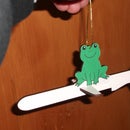Introduction: Hang a Plate on the Wall
I had been given a lovely hand-painted plate which I wanted to display.
Putting it on a shelf was a bad idea as we get lots of earthquakes in New Zealand, so I wanted it safely hung on the wall.
This Instructable shows how I made a wooden backing and then produced some strong metal clips which would hold the plate securely.
Step 1: Make the Plywood Backing
To minimise flex in the clips holding the plate, I wanted them to be attached to a solid backing piece as close to the edge of the plate as possible, but I also didn't want the wooden backing to detract from the plate.
To get the wood the same size as the plate, I used the very high-tech method of placing the plate on a suitable piece of scrap plywood and drawing around it with a pencil.
Clamping the ply securely to a bench let me cut around it with a jigsaw. I made two cuts, both starting where the circle kissed the outside edge of the ply. That meant that there was maximum support under the tool at the final moment when the two cuts joined and the circle was cut free.
Step 2: Shape the Wire Holders
The metal holders were made from #8 wire (what else).
I cut piece about eight inches (20cm) long, clamped the middle of it in a pair of pliers and bent the two legs down at a sharp ninety degrees. (fourth photograph above).
I decided to allow the holders to project about three-quarters of a inch in from the rim of the plate, so I used the pliers again to put a ninety degree bend in the holder three-quarters of an inch (18mm) from the end of the clip (fifth photograph above)
The next bend needed a little measuring as it covered the depth of the finished piece, from the front of the plate to the rear of the backing. This got another two bends to give the shape shown in the sixth photograph above.
Finally, I cut the legs off to give an equal and reasonable length as shown in photograph seven above.
Since it doesn't deserve a step to itself, I also at this point drilled a half-inch hole in the middle of the backing piece to give some clearance for the hanging hook later.
Step 3: Varnish the Wood
Since I didn't want the backing piece to detract from the plate, I stained it with a fairly dark brown. A couple of thick coats, with a quick fine sand between them gave quite a nice finish.
Step 4: Make Securing Clips
During early experiments, the wire holders were temporarily attached to the wood with small cable clips.
To give a robust and reliable solution for long-term use, I took a three inch (75mm) length of wire and wrapped each end around the shaft of a small dome-headed screw.
The little clip which resulted is shown in the second photograph above.
It took a few tries to get the trick, but if you mess up, cut another three inches of wire and try again.
Step 5: Fix Lower Two Brackets
As a final step in making the metal holders, I bent the last quarter-inch of the legs over, to make a makeshift nail as shown in the first photograph above.
The two brackets at the lower edge of the wood had their "nails" hammered into the back of the wood, and then the metal clips made in the previous step were screwed tightly into place.
The bottom two brackets hold the weight of the plate, and that ends up being transmitted through the nails which are horizontal in the wood. The metal clips are there to stop the wire straightening or the nails pulling out.
Step 6: Fix Removable Top Bracket
Since the top bracket only holds the plate back it is under less stress, so it was the lucky winner of the "no-nail" stakes.
Since the final bracket had to be fitted while the (ceramic) plate was tight against the face of the wooden backing, it couldn't really be hammered in, so I snipped the nails from the top bracket and it is help against the wooden backing with only the metal clip. That is plenty secure enough for the job it has to do.
A small brass hanging rail was screwed over the clearance hole drilled earlier, and the whole thing was carefully hung on a picture hook, which was then levered closed with a screwdriver to prevent the thing bouncing off in a quake.
Final result, something which I am confident will stay in place during a shake. Unless it gets hit by the chimney coming down.











